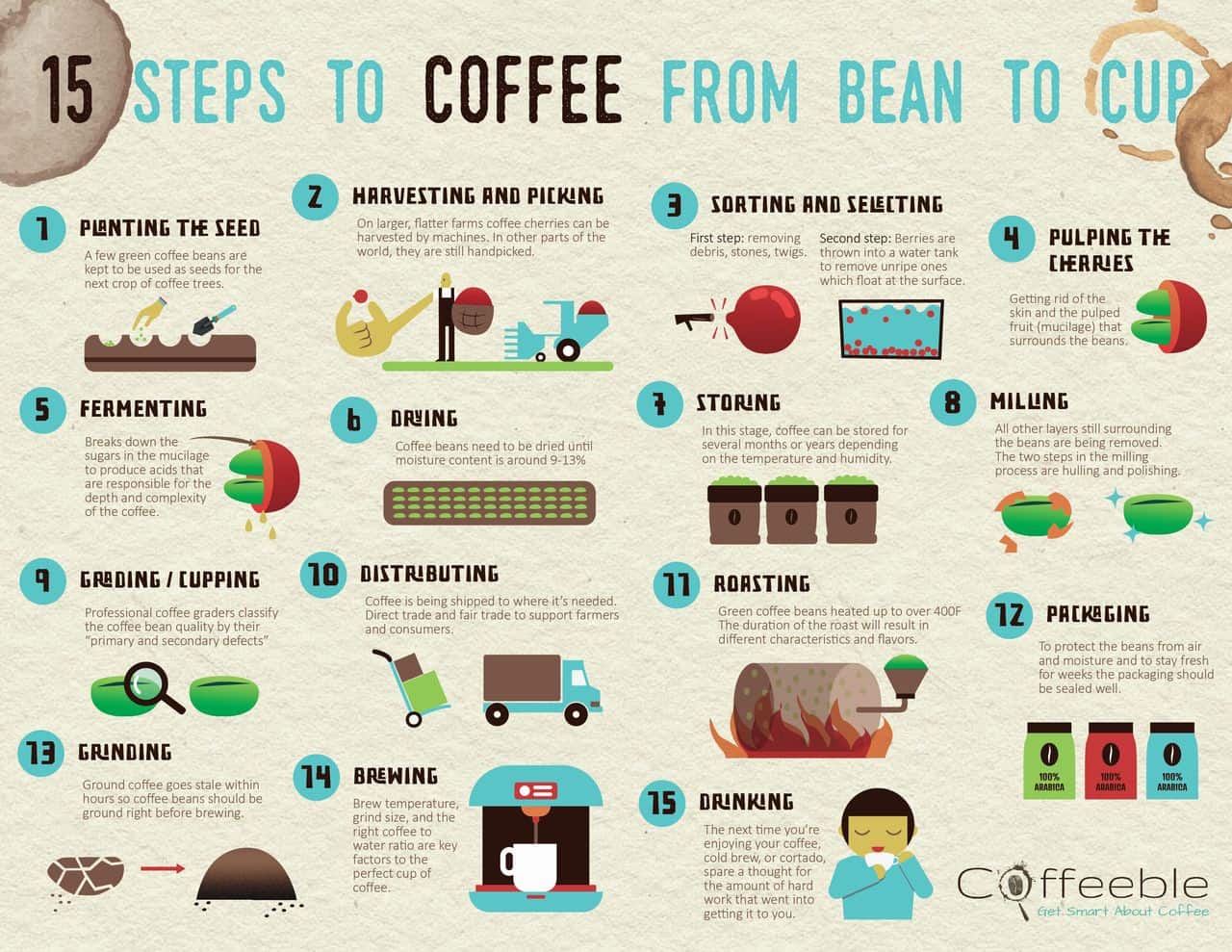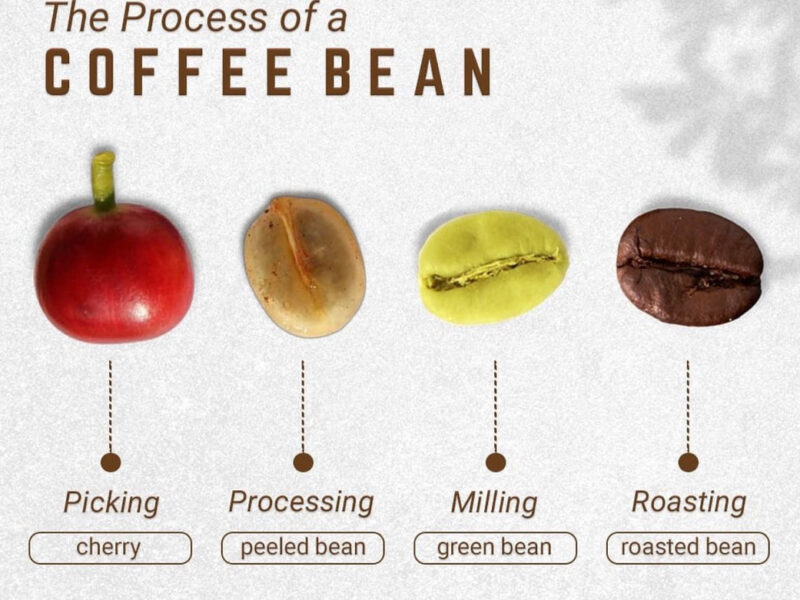Imagine waking up to the aroma of freshly brewed coffee, its rich scent enveloping your senses and promising a delightful start to your day. But what if you could enhance this experience by delving deeper into the world of coffee beans?
Understanding how to process coffee beans can transform your morning ritual into a sensory adventure. Picture yourself savoring each sip, knowing the journey these beans have taken from farm to cup. This article will guide you through the art and science behind processing coffee beans, revealing secrets that can elevate your coffee-making skills.
Discover how you can unlock flavors and aromas that will captivate your taste buds and make your mornings truly extraordinary. Keep reading to uncover the steps that can turn an ordinary cup of coffee into a masterpiece crafted by you.
Coffee Bean Basics
Understanding coffee bean basics is the first step to brewing the perfect cup of coffee. Knowing your beans lets you appreciate the complexities behind your favorite morning ritual. Coffee beans are not just seeds; they are a world of flavors waiting to be unlocked. Ever wondered why your coffee tastes different depending on where you buy it? Let’s dive into the essentials.
Types Of Coffee Beans
There are four main types of coffee beans, each with unique characteristics.
- Arabica:The most popular and widely consumed. It’s known for its smooth, mild taste and is often preferred for high-quality brews. Arabica beans are grown at higher altitudes, which contributes to their rich flavor.
- Robusta:Known for its strong and bold flavor. It contains higher caffeine content, making it a favorite for espresso lovers seeking that extra kick. Robusta beans are more resilient and can be grown in lower altitudes.
- Liberica:Rare and unique, offering an unusual floral and fruity aroma. If you ever get the chance to try it, you might be surprised by its distinct profile. Liberica is primarily grown in Malaysia and the Philippines.
- Excelsa:Often used to add depth to coffee blends. It offers tart and fruity notes that can enhance a coffee’s complexity. Excelsa beans are mostly cultivated in Southeast Asia.
Have you ever tasted these different beans? Each brings a unique experience to your palate.
Growing Regions
Where your coffee beans grow plays a significant role in their flavor profile. Coffee is cultivated in the ‘bean belt’ around the equator.
| Region | Characteristics |
|---|---|
| Africa | Coffee from Ethiopia and Kenya often have bright, fruity notes with floral undertones. |
| South America | Brazilian and Colombian coffees are known for their rich, chocolatey taste and medium acidity. |
| Asia | Indonesian coffee, such as Sumatra, offers earthy and spicy flavors. |
| Central America | Coffee from Costa Rica and Guatemala typically has balanced acidity with nutty and chocolate notes. |
Have you noticed your coffee tastes better when you buy from certain regions? Knowing the growing region helps in selecting the coffee that suits your taste. Next time you sip your coffee, think about its journey from the bean belt to your cup.
Understanding these basics can transform your coffee experience from mundane to extraordinary. Are you ready to explore the world of coffee beans further? The journey awaits, starting with your next cup.

Credit: beannbeancoffee.com
Harvesting Coffee Cherries
Harvesting coffee cherries is the first step in processing coffee beans. Choose ripe cherries for the best flavor. Carefully remove the cherry pulp to reveal the coffee bean inside.
The journey of coffee, from bean to cup, starts with harvesting the perfect coffee cherries. This initial step is crucial for determining the quality of your coffee. A single mistake in timing or technique can significantly affect the flavor profile of your brew. To ensure you get the best possible beans, let’s dive into the essential steps of harvesting coffee cherries.When To Harvest
Timing is everything when it comes to harvesting coffee cherries. The cherries need to be perfectly ripe. This usually means they should be bright red, but it varies depending on the coffee variety. Picking too early or too late can lead to bitter or bland coffee. Have you ever noticed how a slightly underripe fruit tastes different? The same principle applies to coffee cherries. Harvesting at the right moment ensures the best flavor and aroma.Methods Of Harvesting
There are mainly two methods: selective picking and strip picking. Selective picking involves choosing only ripe cherries. This method is labor-intensive but results in higher quality coffee. Picture yourself walking through a coffee farm, hand-picking the ripest cherries—it’s as meticulous as it sounds but worth every effort for the quality it delivers. Strip picking, on the other hand, involves removing all cherries from a branch at once. This method is faster and less costly. However, it doesn’t discriminate between ripe and unripe cherries. It works well for coffee meant for mass production where quantity matters more than quality. Consider your priorities—are you aiming for the perfect cup or a quicker process? Your choice of method will depend on your specific goals and resources. Each method has its own advantages and challenges. How do you decide which is right for you? Assess your resources and desired outcomes to make the best choice for your coffee harvesting journey.Processing Methods
When you sip your favorite coffee, have you ever wondered how the beans were processed? The journey from coffee cherry to cup is fascinating and pivotal. Processing methods significantly influence the taste and quality of your brew. Let’s dive into the three main methods: washed, natural, and honey processing.
Washed Processing
Washed processing, also known as wet processing, is a meticulous method. It involves removing the cherry’s pulp before drying the beans. This ensures a clean taste, highlighting the bean’s inherent flavors. Imagine sipping a cup where every note is crisp and well-defined.
During my visit to a coffee plantation, I saw how the beans were soaked in water to ferment. This step enhances the beans’ flavor profile. The farmer explained that this method demands precise timing and care. It’s a labor of love that results in a vibrant and balanced brew.
Natural Processing
Natural processing, or dry processing, is one of the oldest methods. Here, the whole cherry is dried before the beans are extracted. This results in a fruitier, fuller-bodied coffee. It’s like tasting a piece of the sun-drenched landscape where the beans were grown.
Walking through a field of drying coffee cherries was unforgettable. I learned that this method relies heavily on weather conditions. The beans need ample sunshine and low humidity. It’s a gamble that pays off with rich and complex flavors.
Honey Processing
Honey processing is a delightful middle ground between washed and natural methods. The cherry’s pulp is partially removed, allowing some mucilage to remain. This imparts a sweet, syrupy characteristic to the coffee. Imagine a brew that’s both smooth and intriguing.
Watching the sticky beans being spread out to dry was eye-opening. The farmer emphasized the importance of careful monitoring. Too much pulp can lead to fermentation issues. But when done right, honey processing delivers a cup with a unique sweetness.
Which method intrigues you the most? Each offers a distinct taste experience. Next time you enjoy your coffee, think about the journey those beans took. Understanding the processing can deepen your appreciation for the drink you love.

Credit: driftaway.coffee
Drying Coffee Beans
Drying coffee beans is a crucial step in the journey from farm to cup. It determines the flavor, aroma, and quality of your coffee. Both sun drying and machine drying offer unique advantages. Whether you’re a coffee aficionado or a budding barista, understanding these methods will elevate your coffee experience. Let’s dive into the drying process and see which might suit your needs best.
Sun Drying
Sun drying is the traditional method used by coffee farmers worldwide. It involves spreading the beans in thin layers under the sun. This method is simple but effective, relying on nature to do the work.
Imagine walking through a coffee farm and seeing rows of beans basking in the sunlight. This process can take several days, depending on the climate. Warm, dry weather is ideal for this method, ensuring even drying.
However, sun drying requires patience and attention. You must turn the beans regularly to prevent mold and ensure uniform drying. It’s a labor of love, but many believe the end result is worth it.
Have you ever tried sun-dried coffee? Its rich, natural flavors might surprise you.
Machine Drying
Machine drying offers a more controlled environment for drying coffee beans. It’s perfect for those who need efficiency and consistency. This method uses specialized equipment to regulate temperature and airflow.
If you’ve ever been to a modern coffee processing facility, you might have seen these impressive machines at work. They dry the beans quickly, reducing the risk of spoilage. This is particularly beneficial in regions with unpredictable weather.
Machine drying allows for precise control over the drying process, resulting in a uniform product. It’s a more industrial approach but guarantees quality and efficiency.
Would you prefer the precision of machine drying or the natural touch of sun drying? Your choice can significantly affect the taste of your coffee.
Both methods have their own charm and challenges. Whether you favor the time-honored sun drying or the modern machine drying, the key is to ensure the beans are dried evenly. This is where the magic begins, setting the stage for that perfect cup of coffee.
Hulling And Polishing
Coffee lovers appreciate the journey from bean to cup. Hulling and polishing play a vital role in this process. These steps ensure the beans are ready for roasting. Let’s explore how each step works.
Removing The Hull
The hulling process removes the outer layer from coffee beans. This layer, or hull, shields the beans. Machines separate the hull from the beans carefully. This step reveals the inner coffee bean. Hulling is essential for quality coffee. It ensures only the best beans move forward.
Polishing Process
After hulling, beans undergo polishing. This step enhances their appearance. Polishing removes any remaining silver skin. It gives the beans a clean, glossy look. This process is optional, but many prefer polished beans. It often makes the beans more appealing for sale.

Credit: www.coffeebeancorral.com
Sorting And Grading
Sorting and grading coffee beans ensures quality. Workers separate beans by size, color, and weight. This process impacts flavor and aroma, crucial for a perfect brew.
Processing coffee beans is a fascinating journey that transforms raw cherries into the aromatic beans we savor every morning. An essential step in this journey is sorting and grading. This ensures that only the best beans make it into your cup. Sorting and grading not only affect the flavor and aroma of your coffee but also its quality and consistency. Let’s dive into the key aspects of this crucial phase.Size And Density Sorting
Size and density sorting is all about ensuring uniformity. When you have beans of similar size, they roast more evenly. This is crucial because uneven roasting can lead to a mix of underdeveloped and over-roasted flavors. Machines typically perform this task by shaking the beans through a series of screens with different-sized holes. I once tried sorting beans manually on a coffee farm in Colombia. It was eye-opening to see how much precision is required to achieve that perfect balance. Would you be able to taste the difference in your morning brew knowing the effort behind each bean?Quality Grading
Quality grading is like giving a report card to coffee beans. This process assesses factors such as the bean’s appearance, aroma, and taste. Defects, such as insect damage or discoloration, are taken into account. The Specialty Coffee Association has set standards for grading, ensuring consistency across the industry. Imagine buying a bag of coffee knowing it’s been scored and graded meticulously. Does that make you appreciate the craftsmanship behind your daily cup a little more? Sorting and grading may seem technical, but they are vital in shaping your coffee experience. Next time you sip, consider the care that went into choosing each bean. Would you explore trying different grades to taste the subtle differences? The journey from cherry to cup is a testament to the dedication of coffee producers worldwide.Storing Coffee Beans
Proper storage of coffee beans preserves their flavor and aroma. Freshness matters. Improper storage can lead to stale coffee. Understanding the right conditions helps maintain quality.
Ideal Storage Conditions
Keep coffee beans in an airtight container. Oxygen spoils coffee quickly. Store them in a cool, dark place. Light and heat affect the beans. Use opaque containers to block light. Avoid storing beans in the fridge. Moisture can damage them.
Shelf Life Considerations
Coffee beans have a limited shelf life. Freshly roasted beans last about two weeks. Check the roast date for freshness. Grind only what you need. Whole beans stay fresh longer than ground coffee.
Use your beans within the recommended time. This ensures the best flavor. Store them properly to enjoy fresh coffee every day.
Roasting Coffee Beans
Roasting coffee beans is an art and science. The process transforms green beans into aromatic, flavorful coffee. The aroma and taste depend on the roast level. Each roast level offers a unique flavor profile. Understanding these levels helps in choosing the right one for your taste.
Light, Medium, Dark Roasts
Light roasts have a bright, acidic flavor. They retain most of the beans’ original characteristics. These beans are light brown with no oil on the surface.
Medium roasts offer a balanced flavor. They have a sweeter, fuller body than light roasts. The beans are medium brown, also without an oily surface.
Dark roasts provide a bold, rich taste. They have a pronounced bitterness and full body. These beans are dark brown to almost black, with an oily surface.
Roasting Equipment
Home roasting can be done with various equipment. Air roasters are simple and easy to use. They work like popcorn machines, circulating hot air.
Drum roasters are more traditional. They provide even heat distribution. These are perfect for those wanting precise control.
Oven roasting is another method. It uses household ovens to roast small batches. This method requires careful attention to temperature and time.
Grinding And Brewing
Grinding and brewing coffee beans is an art that transforms simple beans into a delicious beverage. The process involves finding the perfect grind size and brewing technique to suit your taste. It’s like solving a puzzle where each piece contributes to the final picture of flavor and aroma. You might wonder, what grind size works best for different brewing methods? Or how can you improve your brewing technique for a richer taste?
Grind Sizes For Brewing Methods
Choosing the right grind size is crucial for extracting the best flavor from your coffee. Different brewing methods require different grind sizes. Here’s a quick guide:
- Coarse Grind:Ideal for French press and cold brew. The larger particles allow for a slower extraction, providing a smooth taste.
- Medium Grind:Perfect for drip coffee makers and pour-over methods. It’s a balanced size that offers a rich flavor without over-extraction.
- Fine Grind:Best for espresso machines. The small particles allow for a quick and intense extraction, capturing the bold essence of the coffee.
Remember, the grind size is your control over the brewing process. A slight change can dramatically alter the taste. Experiment with different sizes to find what suits your palate.
Brewing Techniques
Brewing coffee is not just about adding hot water to ground beans. It’s a ritual that can be tailored to your taste preferences. Consider these techniques:
- Pour-Over:This method allows you to control the brewing time and water temperature. It’s a hands-on approach where you pour hot water over coffee grounds, extracting complex flavors.
- French Press:Simple and forgiving. You steep coarse grounds in hot water, then press them down with a plunger. This method gives a full-bodied taste.
- Espresso:For those who love bold flavors. It uses pressure to force hot water through fine grounds, resulting in a concentrated shot of coffee.
Each brewing technique offers a unique flavor profile. Ask yourself, do you prefer a smooth cup or a strong shot? The choice is yours, and the possibilities are endless.
As you experiment, keep track of your preferences. A small journal can be a fun way to remember your favorite grind and brew combinations. This journey is about discovering what you enjoy most in a cup of coffee. Whether you are a seasoned coffee lover or a curious beginner, grinding and brewing is your gateway to a world of flavors. Dive in and savor the experience!
Frequently Asked Questions
How Do You Roast Coffee Beans At Home?
Roasting coffee beans at home is simple. Use a pan or an oven. Heat the beans until they turn brown. Stir frequently to ensure even roasting. Once roasted, cool the beans before grinding. Enjoy freshly roasted coffee for a rich flavor.
What Is The Best Way To Grind Coffee Beans?
The best way to grind coffee beans is using a burr grinder. Burr grinders offer consistent grind size, enhancing coffee flavor. Adjust the grind size based on your brewing method. Coarse for French press; fine for espresso. Clean the grinder regularly for optimal performance.
How Long Should Coffee Beans Rest After Roasting?
Coffee beans should rest for 24 to 48 hours after roasting. This resting period allows gases to escape, enhancing flavor. Store them in an airtight container to preserve freshness. Use the beans within two weeks for the best taste experience.
Can You Freeze Coffee Beans For Freshness?
Yes, you can freeze coffee beans to preserve freshness. Use airtight containers to prevent moisture exposure. Freeze in small batches for convenience. Thaw beans at room temperature before grinding. Freezing extends their shelf life without compromising flavor.
Conclusion
Processing coffee beans can be a rewarding experience. It begins with selecting quality beans. Then, follow the steps for roasting and grinding. Each step affects flavor and aroma. Experiment to find your preferred taste. Remember, patience is key to perfect results.
Clean equipment ensures the best flavor. Freshly ground beans yield a richer brew. Enjoy the journey of discovering coffee’s unique profiles. Practice enhances skill and enjoyment. Share your creations with friends and family. Celebrate the art of coffee-making. Embrace the process.
Savor every cup.







